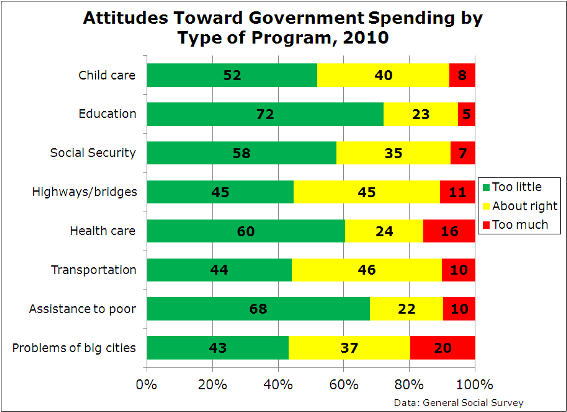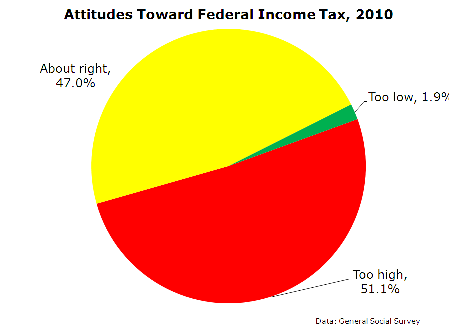Americans Do NOT Want To Cut Government Programs
Conservatives sometimes assert and often imply that Americans want to cut government spending on social assistance and other programs. This is a myth.
In fact, when it comes to the types of programs that get most of the attention in our national debate, almost nobody supports spending reductions and, in many cases, there is strong support for increases.
Take a look at the figure below, which presents General Social Survey data for 2010. Each bar presents the distribution of responses to questions of whether the U.S. spends too much (red), about the right amount (yellow) or too little (green) on several different types of programs and public resources.
As a whole, the types of programs in this graph represent a very large share of total spending at all levels of government. In every single case, 80-95 percent of respondents feel that spending is either “too low” or “about right." And there is at least fairly strong support for increasing spending on assistance to the poor (68 percent), education (72 percent) and health care (60 percent).
The vast majority of Americans are opposed to cutting programs, and any assertion to the contrary is unsupported political rhetoric.
There is, however, one problem, and it’s clear in the graph below, which presents answers to the question of whether respondents' federal income taxes are too high, too low or about right.
Americans don’t want to pay more, at least not in federal income tax (see here). Only the tiniest minority of Americans feel their taxes are too low, while about half actually think they should be paying less.
In other words, most Americans think the country should be spending more, but they themselves don't want to pay for it.
- Matt Di Carlo



I can believe your final conclusion, but I don't think you provided enough evidence for it.
What do Americans think about our government spending on the wars in Iraq and Afghanistan? The expansion of our drone program? Foreign aid? Bank bailouts? Until we know the opinions on those subjects, we can't say for sure that Americans want the government to spend more. We just know they want the government to spend more on the areas you have noted.
I expect that Americans want a reduction of government spending in some if not all of those areas.
And, of course, this debate, as framed by the conservatives, sidesteps the more important question (and does so intentionally, I imagine): What are the social, economic, and political consequences of cutting funding from infrastructure, education, the social safety net, and other essential platforms upon which our society and economy are built?
After reading your post I did some research. Seems that when you look at the trends, the data paint a different picture.
http://brainoids.wordpress.com/2011/02/24/sneak-peek-of-the-2010-genera…
"-Solid and sustained support for Education spending (always perplexing given how little influence the Federal government has here)
-Significant downturn in net support for both Health and the Environment. In both cases, it is hard to see the changes (especially when viewed historically) as anything other than major backlash against recent public policy initiatives in these areas.
-Recent decreases in support for spending on Urban Issues, Social Security, Racial Inequality, and Welfare, as well as International Aid. As fiscal austerity looms, social spending does not seem well favored.
-A somewhat surprising uptick in support for Defense spending – surprising in that the most recent defense downturn has only just started, and not yet cut very deeply."
Come on Man....
Dave,
Obviously an important point.
I looked at the trend in the education variable here: http://shankerblog.org/?p=1456 (also see this post: http://shankerblog.org/?p=2127).
My plan was to address the trends in the other attitudes in a future post, but I guess I don't have to.
Note, however, that some of the long-term changes are rather small, and it's hard to tell whether the short-term declines in others will persist (though I suspect this will be the case with healthcare).
In addition, the focus of this post was more about how many people want to spend less (i.e., "cut"), rather than support per se. Yes, these data are cross-sectional, but the proportion of Americans who want to spend less remains quite low.
Thanks for the comment,
MD
Appreciate the reply. To often the "real world" depicted in the media clashes dramatically with the reality of the neighborhood. The declining trends can reflect a simple fact. Folks are tired of paying for government programs that are motivated more by their political popularity rather than their efficiency and effectiveness in meeting the needs of the those they should be serving.
Thanks again!